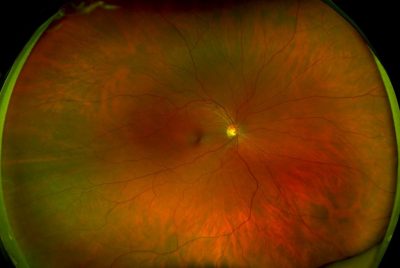In The Frame July 2021
View a PDF of our newsletter here
Welcome to this edition of in the frame. I hope it finds you well and looking forward to the easing of social restrictions over the summer. the practise has been getting steadily busier through the Spring. Many patients have now received both vaccinations and have felt more comfortable going back to the business of normal life. We are back to full strength staff wise, although practice manager Kate, is still on reduced hours as she continues to hobble with her hip still causing her some discomfort. Hopefully, some physio is going to help her with this
I am personally really looking forward to the opening of cafes for tea and cake. I have never been a great pub goer, but I do enjoy a walk by the sea followed by a pot of tea and a scone, or a piece of tray bake. I love the Buckley Hotel in Beaumaris. Comfy sofas and lovely views – in the winter they have real fires and serve hot chocolate. What’s not to love
Optics now and then
Much has changed in the world of optics in the 30 years during which I have been qualified. It seems that every year there has been a step forward that has changed practise. This has made for an interesting career, but frequently one where one must run to keep up. I thought it might be interesting to look back on some of those changes. Today I’m going to look at visual field testing.
Visual field testing looks at what we can see out of the corners of our eyes whilst looking straight ahead. humans have roughly 180 degrees of visual field. Each individual eye has about 150 degrees and the two eyes overlap by about 120 degrees. This overlap is called binocular vision. Binocular vision gives us precise depth perception which helps with everything from walking to catching a ball. A patient is considered to have low vision if they have 20 degrees of field or less in their better seeing eye.
Visual field testing is used to tell us if there is damage to the visual system anywhere between the eyeball and the occipital cortex – the part of the brain at the back of the head where we do our seeing. Damage can come about from ocular disease such as glaucoma or macular degeneration, or also from strokes or head trauma.
It is important to know about visual field that defects for diagnosis of pathology, but also for advising patients on lifestyle matters such as driving.
In my first job, I worked in a practice where we tested fields using a Bjerrum Screen. This was a one metre square of black felt hung on the wall which was marked with concentric rings and radial lines. I would stand beside it with a black wand with a small white target on it. With one of their eyes covered, I would ask the patient to look at the centre of the square and tell me when they could just see the white dot as I moved the target in from the side. This was not cutting edge; however, this was rural Northumberland and I felt like the bees’ knees!
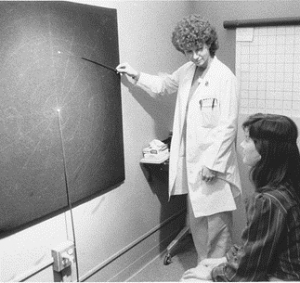
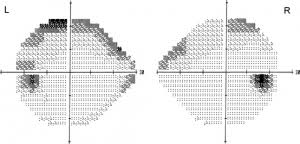
With thanks to the American Academy of Ophthalmology
Today we test fields using automated perimeters. These devices are connected to computers which run tests according to the patient responses. They allowed the task of field testing to be delegated to trained technicians, saving time for the optometrist as they now only need to read the field plots rather than undertake the testing. They produce results which are standardised and repeatable, with an automated print out if required. At Jacksons, we have two field testing devices. Our FDT takes about 30 seconds per eye and is used as a screener. Our Henson 8000 is a much more detailed test which takes between 3:00 and 8:00 minutes per eye. We use this where we have concerns about the visual system and for certain hospital monitoring pathways.
Optomap – Ultra wide field retinal imaging
We are all extremely excited about a new piece of equipment that we have been trying out. Optomap is a special retinal camera which takes an ultra-widefield picture of the back of the eye. This allows us to view the peripheral retina, without the need to use dilating drops. We can gain a view of up to 200 degrees, 82% of the retina whereas, when we take conventional photographs, we only see 45 degrees.
The Optomap was developed by a Scottish engineer whose son went blind in one eye at the age of 5 due to a retinal detachment that was not detected by the hospital. He set out to invent a device that would reduce the risk of this happening to others, and the Optomap was born.
We have trialled the device on our patients for the past 2 weeks and have been impressed with the images we have obtained. This kit is more the province of hospital eye departments than high street optometry practices however, we believe Jacksons patients deserve the best. I have therefore placed the order and hope that ours should arrive around mid-June.
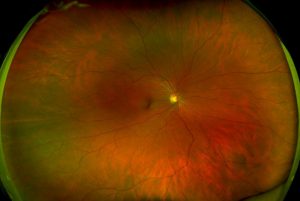
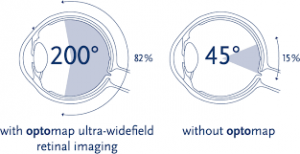
Optomap ultra-wide field retinal imaging along with OCT deep retinal scanning will be included in our routine, private eye examination. It will be available to NHS funded patients for an additional fee.
From my father’s pen
Never volunteer
What should one do in retirement? Certainly, do not volunteer!
Having a lifetime interest in aviation, I was visiting a local aircraft museum in Cheshire, with my friend of some 60 years, when I heard him volunteer my services as a helper – some friend! So, for eight years now, I’ve been a volunteer at the Avro heritage museum, Woodford, as an archivist looking after some of the larger exhibits, we have in storage.
The story I want to tell is of our star exhibit- a replica cockpit of an Avro Lancaster. The cockpit is based on airframe R5868. Built by Metropolitan Vickers in Manchester, this was the 27th of a total of 7377 built. Of these 3736 were lost during hostilities.
During WWII, the average life span of a bomber aircraft was between 8 and 12 operations. R5868 completed 146 such trips.
Allocated initially to 83 squadron based at Scampton in Lincolnshire, it was coded OL-Q and became known as “Queenie” after the war it would return to Scampton and stood and stand for many years as gate Guardian
It was there that one of the fitters who had worked on the aircraft during the war, saw the sorry condition, and after a long campaign, got the RAF to agree, under his guidance, to refurbish the aeroplane. it now stands in the main Bomber Hall at RAF Museum, Hendon.
Working with his father on the refurbishment, was “Martin”. Energised by the refurbishment, he started his own crusade to build a replica. Thinking more modestly, he decided to build a replica cockpit rather than a whole plane! Obviously, there were no airframes available, so the fabric of the aircraft is made of wood and tin plate.
While the exterior is not original, every part inside was fitted out with genuine Avro Lancaster parts, covering the areas of Wireless Operator, Navigator, Fight Engineer, Bomb Aimer/ Front Gunner and Pilot.
Stepping into the interior, visitors get a sense of what it was like for the crew in that cramped, claustrophobic space. They can experience clambering over the infamous main wing spa to access their stations and come to understand how difficult it would be to exit the aeroplane in an emergency.
That the task of building his masterpiece took “Martin” many years is no surprise, and that it cost a fortune and demanded an understanding family, goes without saying. “Martin” loved his replica, but times change, and eventually it was acquired by the museum.
To return to “Queenie” and 83 squadron. On the 27th of September 1943, she was transferred to 467 Squadron, Royal Australian Air Force, based initially at Bottesford, Leicestershire and then to Waddington, Lincolnshire. He is she received new codes of PO-S – “Sugar”, and it was here that she would complete her war.
To those visiting either Hendon or Woodford, those original and replica standards in memorial to the near 56,000 aircrew killed during the hostilities, all of whom were volunteers, but unlike me, volunteers who were truly essential.
Our “Sugar” is but one part of the museum which traces the history of A.V. Roe & Co from the late 1800s to 2014 when Woodford as a working aerodrome manufacturing the BAE Nimrod maritime patrol aircraft, finally closed the doors.
Generously BAE felt history should be perpetuated, and built the museum using the skeleton of what had been the old fire station. With it came a complete Avro Vulcan code XM603 and its twin XM602 (cockpit only) into which the public have access.
Working at Woodford for an enthusiast is akin to being allowed into Aladdin’s Cave. the interaction with our visitors, who come from all around the world, and seeing their appreciation of the “AVRO Story” is the icing on the cake.
I have even forgiven my best mate!
Shirley Sykes
Many of you have admired the pictures I have hung in the practice since our reconfiguration last summer. They are by an artist who lives in Snowdonia called Shirley Sykes.
Shirley is a retired pig farmer with a passion for art. Born in the North East of England to a Welsh coalminer, she moved to Wales 35 years ago to a smallholding. Here she raised pigs and suckling cows. Always an art lover, at the age of 72 she decided to attend Coleg Menai- and local training college, to do a Fine Arts & Design course. Taking the Snowdonia landscape surrounding her home as her inspiration, she has gone on to hone her craft. She loves to paint in acrylics, oils, and pastels. Her work is often bold in colourful.
I met Shirley when she held an exhibition locally, and Bangor’s Deniol Shopping Centre. She and another local artist, Jim Hamilton frequently exhibit there, his very naturalistic style being a perfect foil. I have to say, that I’m captivated by her work. I love the bold, sometimes inappropriate use of colour. We have bought many pieces from her and when we reconfigured the practice, I saw the perfect opportunity to display some of them! Many people have admired them since they were hung and asked for her contact details.
She has a Facebook page – Shirley Sykes, Local Artist www.facebook.com/ShirleySykesOriginal
She can be contacted by email at rose.tydden7@gmail.com
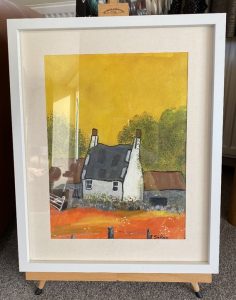
A good read – Lost Houses in Nantwich
If you like local history, you may well enjoy this excellent little book
It features halls, houses, and cottages around Nantwich along with some commercial properties that are no longer in existence. It is illustrated with maps and rare old photographs of fascinating and different buildings that once stood in the area but have now sadly being demolished. The updated edition, which is available through Nantwich museum, has been expanded, and is now recommended to anyone who has lived in Nantwich, or is interested in what Nantwich used to look like.
The book is available to buy through Nantwich museum website at
https://nantwichmuseum.org.uk/product/lost-houses-in-nantwich/
About In The Frame
In The Frame is a periodic conversation about life as it looks from the helm of SW & C Jackson.
I believe in relationships and we really value having a strong relationship with our patients. This is our way of being open and showing people what we’re like. For new patients, this unusual publication is an open dialogue between us so that you can get to know who we are as a company. And painful as it can be, we like to show some of our personality. We’re not a faceless company. For regular patients, many of you only come in once a year or once every two years so we can go a long time without seeing you. And a lot can happen in a year or two. Hence, we like to keep in touch. Your feedback is invaluable. I’m extremely interested in what our customers have to say. Please send your thoughts and comments on what we’re talking about to jacksonsopticiansnantwich@gmail.com
Follow us on Facebook and Instagram
If you are on Facebook, why not visit our page @SW&C Jackson Opticians. We post all sorts including eye health information, special offers, practice news and insights as to what we all get up to when we are not at work. Frequently I will read articles in my professional journals such as the latest thinking on the management of wet age-related macula degeneration or dry eye therapy and I will create a link to the page. If you have 5 minutes, it’s worth a look www.facebook.com/JacksonsOpticiansNantwich/
Instagram – Helen Corson@JacksonsOpticiansNantwich



